Weak Metal–Support Interaction over CuO/TiO2 Catalyst Governed Low-Temperature Toluene Oxidation
Abstract
1. Introduction
2. Materials and Methods
2.1. Chemical
2.2. Catalyst Preparation
2.2.1. The Synthesis of CuO-TiO2(coll) and TiO2
2.2.2. The Synthesis of CuO/TiO2(imp)
2.3. Catalytic Activity Test
2.4. Kinetic Analysis
2.5. Catalyst Characterization
3. Result and Discussion
3.1. Catalytic Performance
3.2. Textural Properties
3.3. Structural Analysis
3.4. Characterization of Surface Element Distribution
3.5. Optical Properties
3.6. Reducibility Studies
4. Conclusions
Author Contributions
Funding
Data Availability Statement
Acknowledgments
Conflicts of Interest
References
- Kamal, M.S.; Razzak, S.A.; Hossain, M.M. Catalytic oxidation of volatile organic compounds (VOCs)—A review. Atmos. Environ. 2016, 140, 117–134. [Google Scholar] [CrossRef]
- Atkinson, R. Atmospheric chemistry of VOCs and NOx. Atmos. Environ. 2000, 34, 2063–2101. [Google Scholar] [CrossRef]
- Liu, H.; Liu, S.; Xue, B.R.; Lv, Z.F.; Meng, Z.H.; Yang, X.F.; Xue, T.; Yu, Q.; He, K.B. Ground-level ozone pollution and its health impacts in China. Atmos. Environ. 2018, 173, 223–230. [Google Scholar] [CrossRef]
- Zhao, Q.; Li, Y.J.; Chai, X.L.; Xu, L.Z.; Zhang, L.F.; Ning, P.; Huang, J.H.; Tian, S.L. Interaction of inhalable volatile organic compounds and pulmonary surfactant: Potential hazards of VOCs exposure to lung. J. Hazard. Mater. 2019, 369, 512–520. [Google Scholar] [CrossRef]
- Zhou, G.; Lan, H.; Yang, X.; Du, Q.; Xie, H.; Fu, M. Effects of the structure of Ce-Cu catalysts on the catalytic combustion of toluene in air. Ceram. Int. 2013, 39, 3677–3683. [Google Scholar] [CrossRef]
- Huang, H.B.; Xu, Y.; Feng, Q.Y.; Leung, D.Y.C. Low temperature catalytic oxidation of volatile organic compounds: A review. Catal. Sci. Technol. 2015, 5, 2649–2669. [Google Scholar] [CrossRef]
- Guo, Y.; Wen, M.; Li, G.; An, T. Recent advances in VOC elimination by catalytic oxidation technology onto various nanoparticles catalysts: A critical review. Appl. Catal. B Environ. 2021, 281, 119447. [Google Scholar] [CrossRef]
- Scire, S.; Liotta, L.F. Supported gold catalysts for the total oxidation of volatile organic compounds. Appl. Catal. B-Environ. 2012, 125, 222–246. [Google Scholar] [CrossRef]
- Liotta, L.F. Catalytic oxidation of volatile organic compounds on supported noble metals. Appl. Catal. B Environ. 2010, 100, 403–412. [Google Scholar] [CrossRef]
- Lin, H.-Q.; Chen, Y.-W. Complete oxidation of toluene on Pd/modified-CeO2 catalysts. J. Taiwan Inst. Chem. Eng. 2016, 67, 69–73. [Google Scholar] [CrossRef]
- Li, Y.; Fan, Y.; Jian, J.; Yu, L.; Cheng, G.; Zhou, J.; Sun, M. Pt-based structured catalysts on metallic supports synthesized by electroless plating deposition for toluene complete oxidation. Catal. Today 2017, 281, 542–548. [Google Scholar] [CrossRef]
- Liu, X.; Zhang, Q.; Ning, P.; Tang, T.; Hu, J.; Su, W. One-pot synthesis of mesoporous Al2O3-supported Pt-Pd catalysts for toluene combustion. Catal. Commun. 2018, 115, 26–30. [Google Scholar] [CrossRef]
- Dai, C.; Zhou, Y.; Peng, H.; Huang, S.; Qin, P.; Zhang, J.; Yang, Y.; Luo, L.; Zhang, X. Current progress in remediation of chlorinated volatile organic compounds: A review. J. Ind. Eng. Chem. 2018, 62, 106–119. [Google Scholar] [CrossRef]
- Liang, X.; Qi, F.; Liu, P.; Wei, G.; Su, X.; Ma, L.; He, H.; Lin, X.; Xi, Y.; Zhu, J.; et al. Performance of Ti-pillared montmorillonite supported Fe catalysts for toluene oxidation: The effect of Fe on catalytic activity. Appl. Clay Sci. 2016, 132–133, 96–104. [Google Scholar] [CrossRef]
- Konsolakis, M.; Carabineiro, S.A.C.; Marnellos, G.E.; Asad, M.F.; Soares, O.S.G.P.; Pereira, M.F.R.; Órfão, J.J.M.; Figueiredo, J.L. Volatile organic compounds abatement over copper-based catalysts: Effect of support. Inorg. Chim. Acta 2017, 455, 473–482. [Google Scholar] [CrossRef]
- Jin, Y.; Quan, Y.; Liu, J.; Qi, C.; Pan, P.; Shan, B.; Luo, H.; Yang, P. Controlled synthesis of niobium and rare earth mixed oxides for catalytic combustion of chlorinated VOCs in the synthesis process of polyether polyol and polyurethane. J. Solid State Chem. 2022, 313, 123318. [Google Scholar] [CrossRef]
- Lee, J.E.; Ok, Y.S.; Tsang, D.C.W.; Song, J.; Jung, S.C.; Park, Y.K. Recent advances in volatile organic compounds abatement by catalysis and catalytic hybrid processes: A critical review. Sci. Total Environ. 2020, 719, 137405. [Google Scholar] [CrossRef]
- Fang, Y.R.; Guo, Y.B. Copper-based non-precious metal heterogeneous catalysts for environmental remediation. Chin. J. Catal. 2018, 39, 566–582. [Google Scholar] [CrossRef]
- Xiong, S.; Huang, N.; Peng, Y.; Chen, J.; Li, J. Balance of activation and ring-breaking for toluene oxidation over CuO-MnOx bimetallic oxides. J. Hazard. Mater. 2021, 415, 125637. [Google Scholar] [CrossRef]
- Zeng, Y.; Haw, K.G.; Wang, Z.; Wang, Y.; Zhang, S.; Hongmanorom, P.; Zhong, Q.; Kawi, S. Double redox process to synthesize CuO-CeO2 catalysts with strong Cu-Ce interaction for efficient toluene oxidation. J. Hazard. Mater. 2021, 404, 124088. [Google Scholar] [CrossRef]
- Al-Hajji, L.A.; Ismail, A.A.; Alsaidi, M.; Ahmed, S.A.; Almutawa, F.; Bumajdad, A. Comparison of TiO2 nanowires and TiO2 nanoparticles for photodegradation of resorcinol as endocrine model. J. Nanoparticle Res. 2020, 22, 10. [Google Scholar] [CrossRef]
- Lu, Y.; Deng, H.; Pan, T.; Wang, L.; Zhang, C.; He, H. Interaction between noble metals (Pt, Pd, Rh, Ir, Ag) and defect-enriched TiO2 and its application in toluene and propene catalytic oxidation. Appl. Surf. Sci. 2022, 606, 154834. [Google Scholar] [CrossRef]
- Chen, W.; Xu, J.; Huang, F.; Zhao, C.; Guan, Y.; Fang, Y.; Hu, J.; Yang, W.; Luo, Z.; Guo, Y. CO oxidation over CuOx/TiO2 catalyst: The importance of oxygen vacancies and Cu+ species. Appl. Surf. Sci. 2023, 618, 156539. [Google Scholar] [CrossRef]
- Fang, Y.; Li, L.; Yang, J.; Hoang, S.; Wang, L.; Xu, J.; Yang, W.; Pan, C.; Zhu, Y.; Deng, H.; et al. Engineering the Nucleophilic Active Oxygen Species in CuTiOx for Efficient Low-Temperature Propene Combustion. Environ. Sci. Technol. 2020, 54, 15476–15488. [Google Scholar] [CrossRef] [PubMed]
- Liu, M.; Yang, X.; Tian, Z.; Wang, H.; Yin, L.; Chen, J.; Guan, Q.; Yang, H.; Zhang, Q. Insights into the role of strontium in catalytic combustion of toluene over La1-xSrxCoO3 perovskite catalysts. Phys. Chem. Chem. Phys. 2022, 24, 3686–3694. [Google Scholar] [CrossRef]
- Hu, J.; Li, W.B.; Liu, R.F. Highly efficient copper-doped manganese oxide nanorod catalysts derived from CuMnO hierarchical nanowire for catalytic combustion of VOCs. Catal. Today 2018, 314, 147–153. [Google Scholar] [CrossRef]
- Li, L.; Zhang, C.; Chen, F.; Xiang, Y.; Yan, J.; Chu, W. Facile fabrication of hollow structured Cu-Ce binary oxides and their catalytic properties for toluene combustion. Catal. Today 2021, 376, 239–246. [Google Scholar] [CrossRef]
- Shen, Y.; Deng, J.; Han, L.; Ren, W.; Zhang, D. Low-Temperature Combustion of Toluene over Cu-Doped SmMn2O5 Mullite Catalysts via Creating Highly Active Cu2+-O-Mn4+ Sites. Environ. Sci. Technol. 2022, 56, 10433–10441. [Google Scholar] [CrossRef]
- Yang, X.B.; Zhang, Z.H. Study on the Performance of Copper-Manganese Composite Oxide Catalysts for Toluene. Chemistryselect 2021, 6, 4837–4843. [Google Scholar] [CrossRef]
- Meng, L. Low-temperature complete removal of toluene over highly active nanoparticles CuO-TiO2 synthesized via flame spray pyrolysis. Appl. Catal. B Environ. 2020, 264, 118427. [Google Scholar] [CrossRef]
- Zhang, Y.; Li, Y.; Zeng, Z.; Hu, J.; Hou, Y.; Huang, Z. Synergically engineering Cu+ and oxygen vacancies in CuMn2O4 catalysts for enhanced toluene oxidation performance. Mol. Catal. 2022, 517, 112043. [Google Scholar] [CrossRef]
- Zhang, W.; Descorme, C.; Valverde, J.L.; Giroir-Fendler, A. Cu-Co mixed oxide catalysts for the total oxidation of toluene and propane. Catal. Today 2022, 384–386, 238–245. [Google Scholar] [CrossRef]
- Lu, H.; Kong, X.; Huang, H.; Zhou, Y.; Chen, Y. Cu-Mn-Ce ternary mixed-oxide catalysts for catalytic combustion of toluene. J. Environ. Sci. 2015, 32, 102–107. [Google Scholar] [CrossRef] [PubMed]
- Song, B.; Li, C.; Du, X.; Li, S.; Zhang, Y.; Lyu, Y.; Zhou, Q. Superior performance of Cu-Ce binary oxides for toluene catalytic oxidation: Cu-Ce synergistic effect and reaction pathways. Fuel 2021, 306, 121654. [Google Scholar] [CrossRef]
- Yan, D.; Mo, S.; Sun, Y.; Ren, Q.; Feng, Z.; Chen, P.; Wu, J.; Fu, M.; Ye, D. Morphology-activity correlation of electrospun CeO2 for toluene catalytic combustion. Chemosphere 2020, 247, 125860. [Google Scholar] [CrossRef]
- Zhang, Q.; Zhang, Y.; Zhang, T.; Wang, H.; Ma, Y.; Wang, J.; Ning, P. Influence of preparation methods on iron-tungsten composite catalyst for NH3-SCR of NO: The active sites and reaction mechanism. Appl. Surf. Sci. 2020, 503, 144190. [Google Scholar] [CrossRef]
- Zhao, C.; Hao, Q.; Zhang, Q.; Yan, N.; Liu, J.; Dou, B.; Bin, F. Catalytic self-sustained combustion of toluene and reaction pathway over CuxMn1-xCe0.75Zr0.25/TiO2 catalysts. Appl. Catal. A Gen. 2019, 569, 66–74. [Google Scholar] [CrossRef]
- Tian, F.; Zhang, Y.; Zhang, J.; Pan, C. Raman Spectroscopy: A New Approach to Measure the Percentage of Anatase TiO2 Exposed (001) Facets. J. Phys. Chem. C 2012, 116, 7515–7519. [Google Scholar] [CrossRef]
- Zedan, A.; Allam, N.; AlQaradawi, S. A Study of Low-Temperature CO Oxidation over Mesoporous CuO-TiO2 Nanotube Catalysts. Catalysts 2017, 7, 129. [Google Scholar] [CrossRef]
- Santara, B.; Giri, P.K.; Imakita, K.; Fujii, M. Evidence for Ti Interstitial Induced Extended Visible Absorption and Near Infrared Photoluminescence from Undoped TiO2 Nanoribbons: An In Situ Photoluminescence Study. J. Phys. Chem. C 2013, 117, 23402–23411. [Google Scholar] [CrossRef]
- Wajid Shah, M.; Zhu, Y.; Fan, X.; Zhao, J.; Li, Y.; Asim, S.; Wang, C. Facile Synthesis of Defective TiO2-x Nanocrystals with High Surface Area and Tailoring Bandgap for Visible-light Photocatalysis. Sci. Rep. 2015, 5, 15804. [Google Scholar] [CrossRef]
- Yang, R.C.; Yang, L.J.; Tao, T.X.; Ma, F.Y.; Xu, M.D.; Zhang, Z.H. Contrastive study of structure and photocatalytic performance with three-dimensionally ordered macroporous CuO-TiO2 and CuO/TiO2. Appl. Surf. Sci. 2014, 288, 363–368. [Google Scholar] [CrossRef]
- Wang, Y.; Xue, R.; Zhao, C.; Liu, F.; Liu, C.; Han, F. Effects of Ce in the catalytic combustion of toluene on CuxCe1-xFe2O4. Colloids Surf. A Physicochem. Eng. Asp. 2018, 540, 90–97. [Google Scholar] [CrossRef]
- Zhao, L.; Huang, Y.; Zhang, J.; Jiang, L.; Wang, Y. Al2O3-modified CuO-CeO2 catalyst for simultaneous removal of NO and toluene at wide temperature range. Chem. Eng. J. 2020, 397, 125419. [Google Scholar] [CrossRef]
- Huang, J.; Wang, S.; Zhao, Y.; Wang, X.; Wang, S.; Wu, S.; Zhang, S.; Huang, W. Synthesis and characterization of CuO/TiO2 catalysts for low-temperature CO oxidation. Catal. Commun. 2006, 7, 1029–1034. [Google Scholar] [CrossRef]
- Yao, J.; Wu, D.; Yan, X.; Wang, B.; Hu, J.; Bao, W.; Chang, L.; Wang, J. Highly catalytic-performance for benzene oxidation: Effect of oxygen species on OMS-2 by Co doping. Fuel 2021, 305, 121538. [Google Scholar] [CrossRef]
- Li, K.; Li, T.; Dai, Y.; Quan, Y.; Zhao, J.; Ren, J. Highly active urchin-like MCo2O4 (M=Co, Cu, Ni or Zn) spinel for toluene catalytic combustion. Fuel 2022, 318, 123648. [Google Scholar] [CrossRef]
- Wei, G.; Zhang, Q.; Zhang, D.; Wang, J.; Tang, T.; Wang, H.; Liu, X.; Song, Z.; Ning, P. The influence of annealing temperature on copper-manganese catalyst towards the catalytic combustion of toluene: The mechanism study. Appl. Surf. Sci. 2019, 497, 143777. [Google Scholar] [CrossRef]
- Jiang, Y.; Gao, X.; Zhang, Y.; Wu, W.; Song, H.; Luo, Z.; Cen, K. Effects of PbCl2 on selective catalytic reduction of NO with NH3 over vanadia-based catalysts. J. Hazard. Mater. 2014, 274, 270–278. [Google Scholar] [CrossRef]
- Wang, Z.; Li, S.; Xie, S.; Liu, Y.; Dai, H.; Guo, G.; Deng, J. Supported ultralow loading Pt catalysts with high H2O-, CO2-, and SO2- resistance for acetone removal. Appl. Catal. A Gen. 2019, 579, 106–115. [Google Scholar] [CrossRef]
- Gao, L.; Gao, W.; Wang, H.; Xu, S.; Tian, X.; Cao, J.; Chen, J.; Zhang, Q.; Ning, P.; Hao, J. Boosting low-temperature and high-temperature hydrothermal stability of Cu/SAPO-34 for NO removal via yttrium decoration. Chem. Eng. J. 2023, 455, 140520. [Google Scholar] [CrossRef]
- Liang, C.; Li, C.; Zhu, Y.; Du, X.; Zeng, Y.; Zhou, Y.; Zhao, J.; Li, S.; Liu, X.; Yu, Q.; et al. Light-driven photothermal catalysis for degradation of toluene on CuO/TiO2 Composite: Dominating photocatalysis and auxiliary thermalcatalysis. Appl. Surf. Sci. 2022, 601, 154144. [Google Scholar] [CrossRef]
- Zeng, Y.; Wang, Y.; Song, F.; Zhang, S.; Zhong, Q. The effect of CuO loading on different method prepared CeO2 catalyst for toluene oxidation. Sci. Total Environ. 2020, 712, 135635. [Google Scholar] [CrossRef] [PubMed]
- Li, C.; Yang, Y.; Ren, W.; Wang, J.; Zhu, T.; Xu, W. Effect of Ce Doping on Catalytic Performance of Cu/TiO2 for CO Oxidation. Catal. Lett. 2020, 150, 2045–2055. [Google Scholar] [CrossRef]
- Barakat, T.; Idakiev, V.; Cousin, R.; Shao, G.S.; Yuan, Z.Y.; Tabakova, T.; Siffert, S. Total oxidation of toluene over noble metal based Ce, Fe and Ni doped titanium oxides. Appl. Catal. B Environ. 2014, 146, 138–146. [Google Scholar] [CrossRef]
- Cai, J.Y.; Yu, Z.H.; Li, J. Effect of Preparation Methods on the Performance of Pt/TiO2 Catalysts for the Catalytic Oxidation of Carbon Monoxide in Simulated Sintering Flue Gas. Catalysts 2021, 11, 804. [Google Scholar] [CrossRef]
- Xie, H.; Xia, D.; Zhou, G. Promoting Effects of Ni for Toluene Catalytic Combustion Over CoNi/TiO2 Oxide Catalysts. Int. J. Chem. React. Eng. 2018, 16, 4734575. [Google Scholar] [CrossRef]

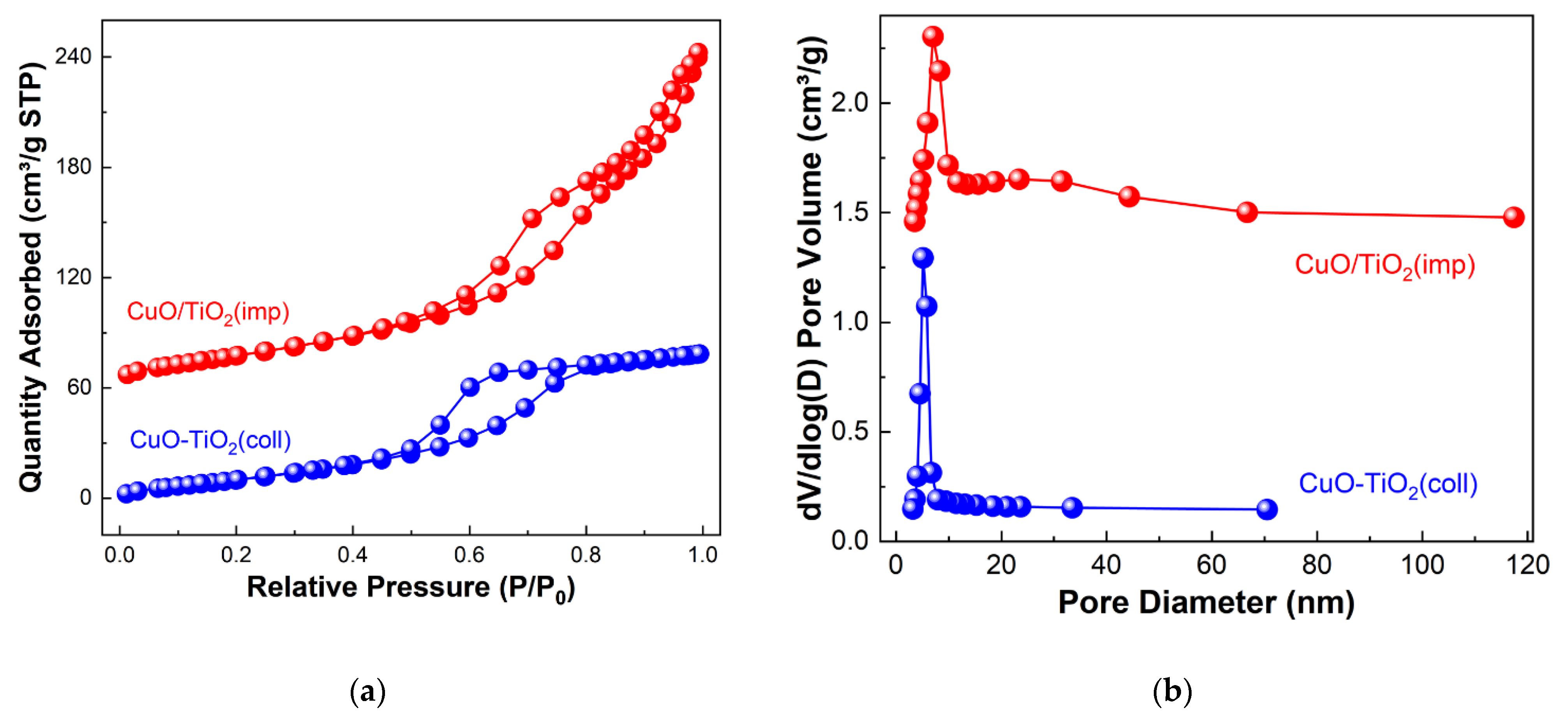

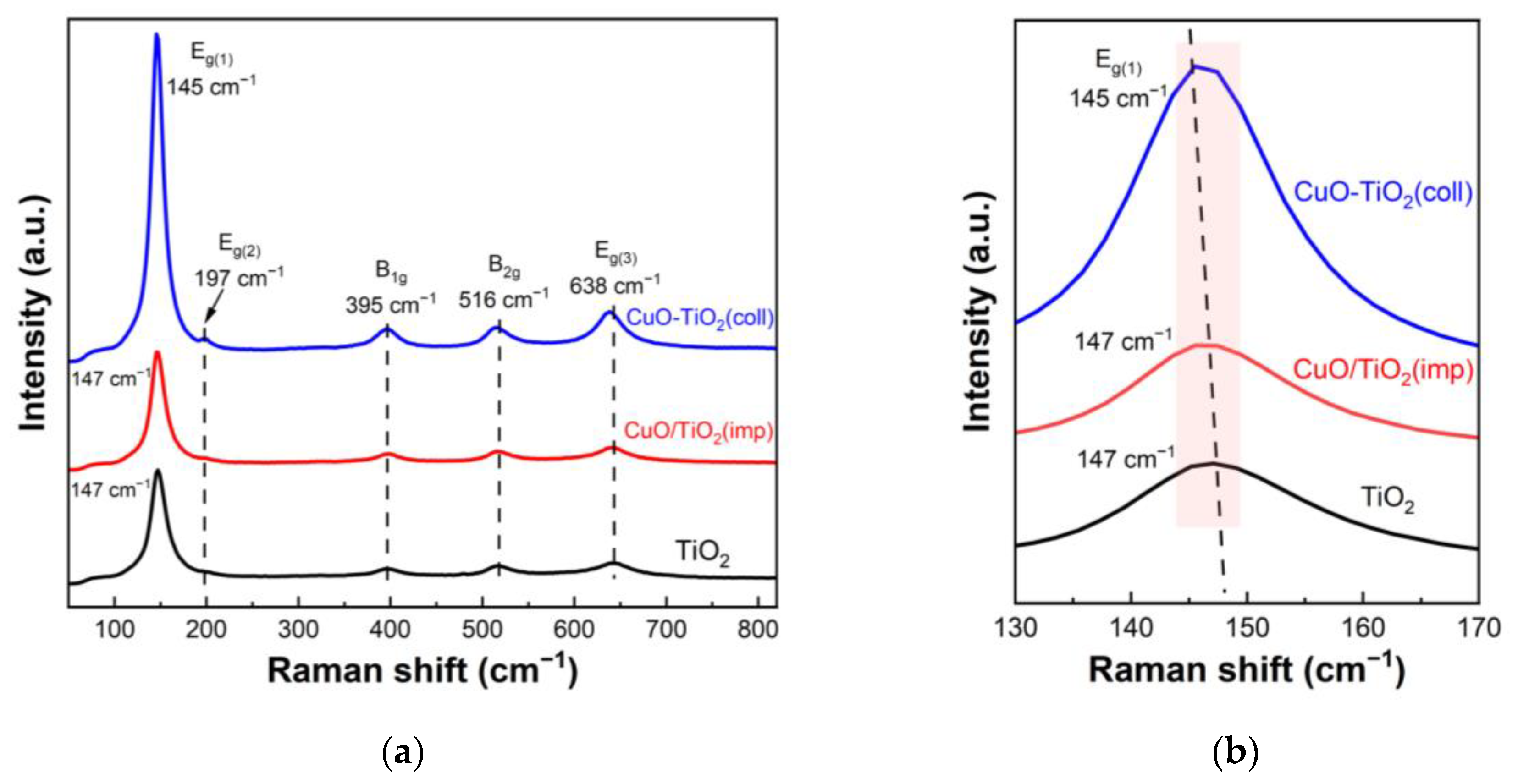
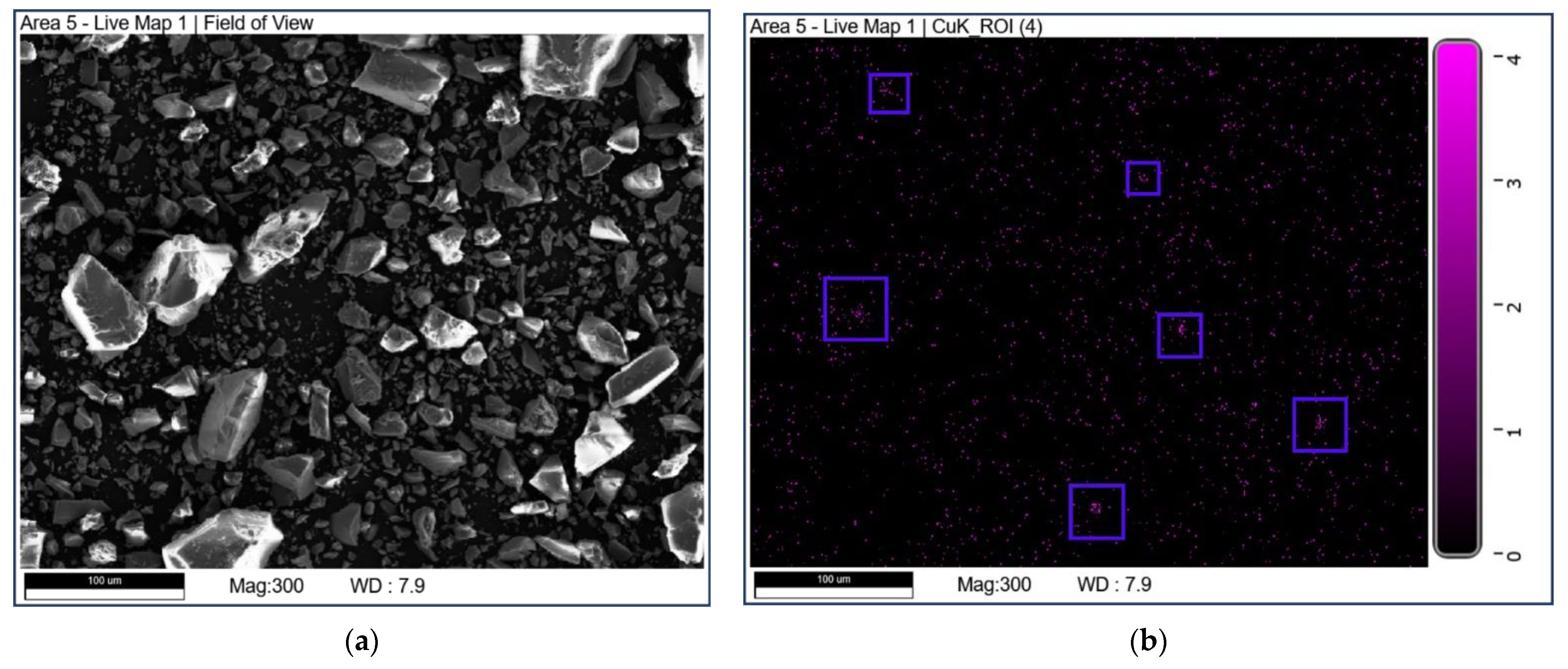


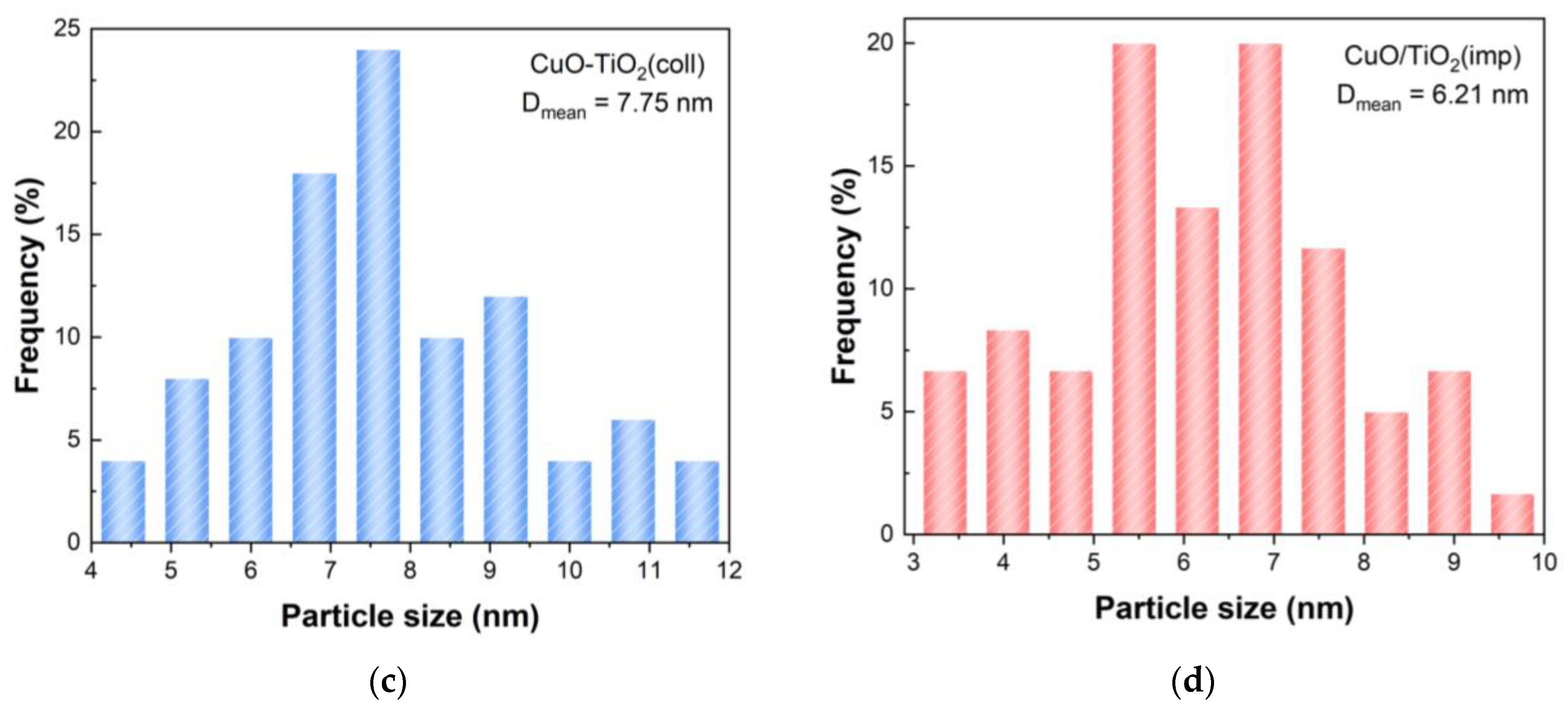
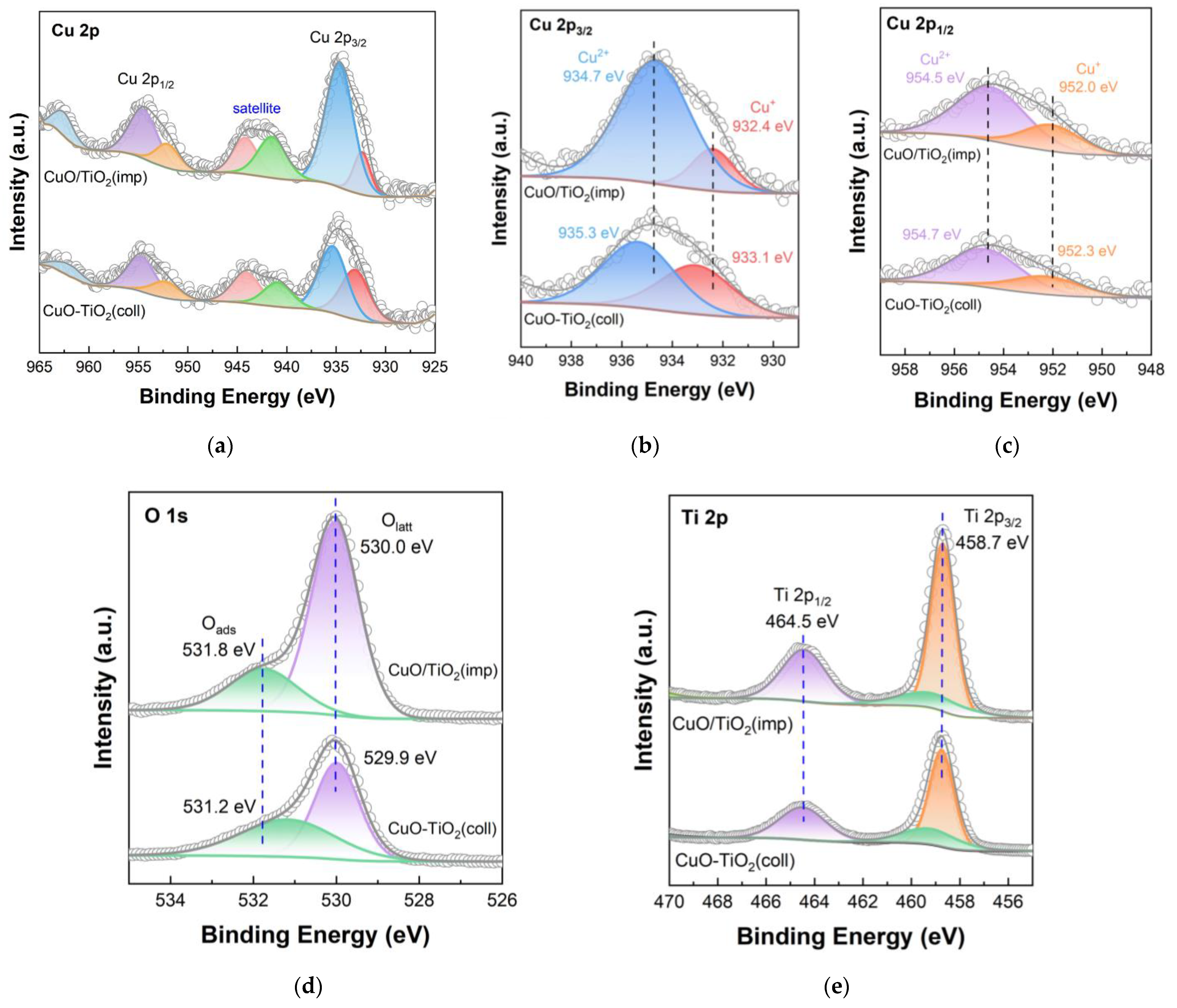
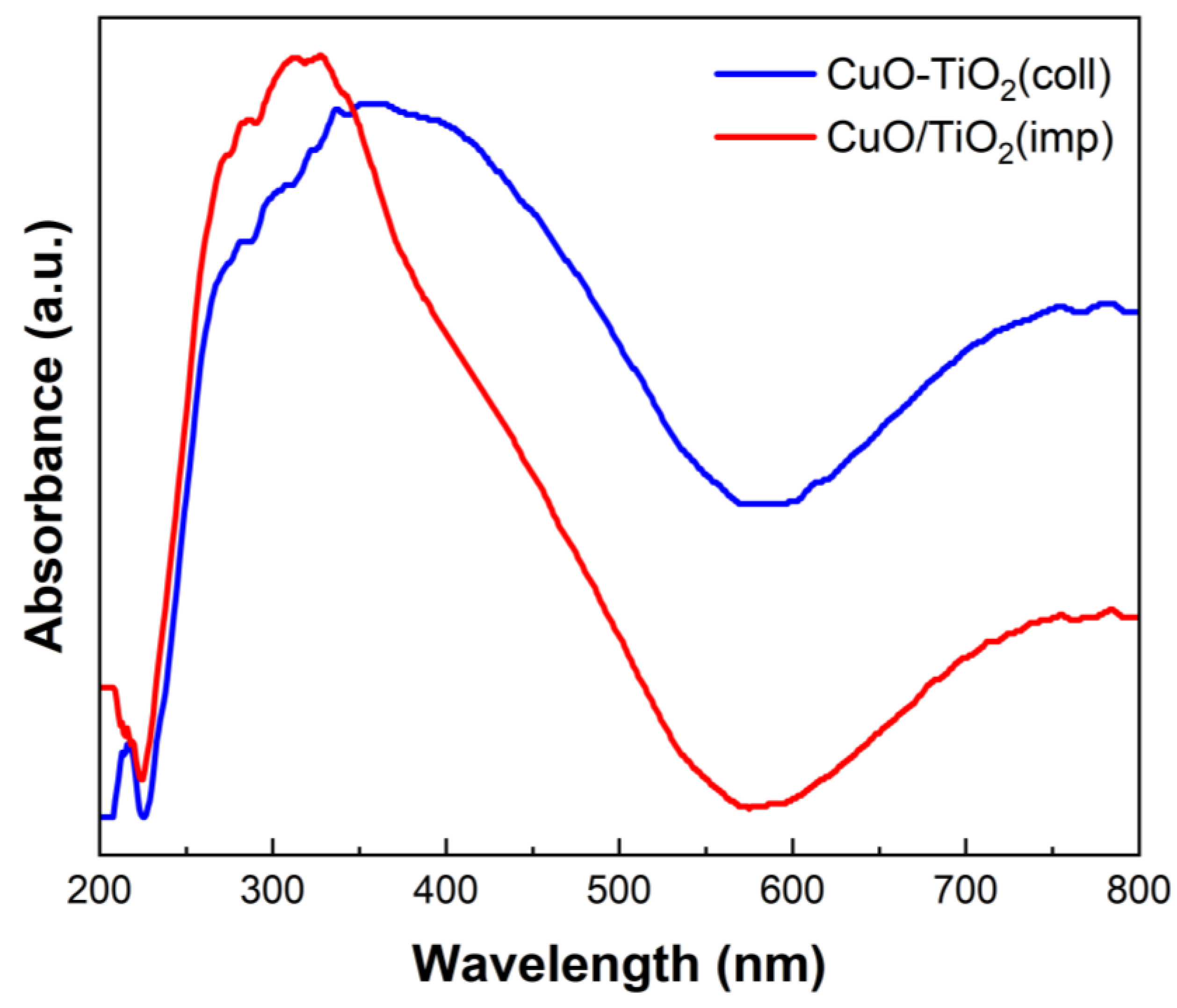

| Catalyst | Reaction Mixture | T50 (°C) | T90 (°C) | Ref. |
|---|---|---|---|---|
| Cu1Mn1O | 1000 ppm toluene, 60 mL·min−1 WHSV: 20,000 mL·gcat−1·h−1 | 206 | 214 | [26] |
| Cu6Ce4Ox | 1000 ppm toluene, 60 mL·min−1, WHSV: 36,000 mL·gcat−1·h−1 | 240 | 260 | [27] |
| Cu-SmMn2O5 | 1000 ppm toluene, 200 mL·min−1, WHSV: 40,000 mL·gcat−1·h−1 | 210 | 222 | [28] |
| Cu1Mn1 | 1000 ppm toluene, WHSV: 10,000 mL·gcat−1·h−1 | 226 | 229 | [29] |
| 20 wt.% CuO-TiO2 | 300 ppmv toluene WHSV: 36,000 mL·gcat−1·h−1 | 182 | 220 | [30] |
| CuMn2O4-EG-350 (ethanol:glycol = 3:1) | 1000 ppm toluene, 66.7 mL·min−1, WHSV: 20,000 mL·gcat−1·h−1 | 202 | 218 | [31] |
| Cu0.2Co | 1000 ppm toluene, 100 mL·min−1, WHSV: 40,000 mL·gcat−1·h−1 | 216 | 238 | [32] |
| Cu1Mn2Ce4 | 5.0 g/m3 toluene 200 mL·min−1, WHSV: 24,000 mL·gcat−1·h−1 | 213 | 218 | [33] |
| Cu1Ce3 | 1000 ppm toluene, 150 mL·min−1, WHSV: 30,000 mL·gcat−1·h−1 | 167 | 178 | [34] |
| CuO/TiO2 | 600 ppm toluene, 100 mL·min−1, WHSV: 20,000 mL·gcat−1·h−1 | 170 | 225 | This work |
| Sample | BET Surface Area (m²∙g−1) a | Total Pore Volume (cm3·g−1) a | Average Pore Size (nm) a | Average Grain Sizes (nm) b | Ea (KJ∙mol−1) c |
|---|---|---|---|---|---|
| CuO-TiO2(coll) | 67 | 0.16 | 6.4 | 7.75 | 42.0 ± 1.0 |
| CuO/TiO2(imp) | 97 | 0.32 | 10.1 | 6.21 | 27.9 ± 2.9 |
| Samples | Cu+ BE/eV | Cu2+ BE/eV | Cu2+/(Cu+ + Cu2+) | Olatt/(Olatt + Oads) | Ti4+ BE/eV |
|---|---|---|---|---|---|
| CuO-TiO2(coll) | 933.1 | 935.3 | 0.61 | 0.77 | 458.7/464.5 |
| CuO/TiO2(imp) | 932.4 | 934.7 | 0.80 | 0.81 | 458.7/464.5 |
| Sample | α Peak | β Peak | χ Peak | δ Peak | ε Peak | Total |
|---|---|---|---|---|---|---|
| CuO-TiO2(coll) | 0.16 a/100 °C b | 1.94 a/143 °C b | 1.01 a/177 °C b | 1.5 a/399 °C b | - c | 4. 61 a |
| CuO/TiO2(imp) | 0.8 a/107 °C b | 1.84 a/132 °C b | 1.35 a/173 °C b | 1.59 a/392 °C b | 0.97 a/555 °C b | 6. 55 a |
Disclaimer/Publisher’s Note: The statements, opinions and data contained in all publications are solely those of the individual author(s) and contributor(s) and not of MDPI and/or the editor(s). MDPI and/or the editor(s) disclaim responsibility for any injury to people or property resulting from any ideas, methods, instructions or products referred to in the content. |
© 2023 by the authors. Licensee MDPI, Basel, Switzerland. This article is an open access article distributed under the terms and conditions of the Creative Commons Attribution (CC BY) license (https://creativecommons.org/licenses/by/4.0/).
Share and Cite
Zou, M.; Wang, M.; Wang, J.; Zhu, D.; Liu, J.; Wang, J.; Xiao, Q.; Chen, J. Weak Metal–Support Interaction over CuO/TiO2 Catalyst Governed Low-Temperature Toluene Oxidation. Nanomaterials 2023, 13, 1859. https://doi.org/10.3390/nano13121859
Zou M, Wang M, Wang J, Zhu D, Liu J, Wang J, Xiao Q, Chen J. Weak Metal–Support Interaction over CuO/TiO2 Catalyst Governed Low-Temperature Toluene Oxidation. Nanomaterials. 2023; 13(12):1859. https://doi.org/10.3390/nano13121859
Chicago/Turabian StyleZou, Meilin, Mingyue Wang, Jingge Wang, Danrui Zhu, Jiaying Liu, Junwei Wang, Qingchao Xiao, and Jianjun Chen. 2023. "Weak Metal–Support Interaction over CuO/TiO2 Catalyst Governed Low-Temperature Toluene Oxidation" Nanomaterials 13, no. 12: 1859. https://doi.org/10.3390/nano13121859
APA StyleZou, M., Wang, M., Wang, J., Zhu, D., Liu, J., Wang, J., Xiao, Q., & Chen, J. (2023). Weak Metal–Support Interaction over CuO/TiO2 Catalyst Governed Low-Temperature Toluene Oxidation. Nanomaterials, 13(12), 1859. https://doi.org/10.3390/nano13121859





